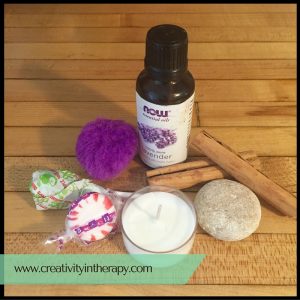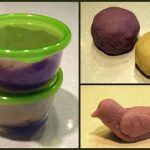Our senses can be powerful emotional triggers. A certain smell can quickly fill us with memories and their accompanying feelings…a soothing touch can help us to feel safe and calm…the right music can energize, fill us with peace, or move us to tears. Even though we’ve all had these experiences, we don’t always think to consciously harness the power of our senses to help ourselves feel better. And while some of us have learned over the years how to soothe and calm ourselves when upset, not everyone has been able to do so.
I’ve been learning more about DBT techniques recently through some trainings and books, as well as hearing adolescent clients share about their experiences doing a DBT-based IOP program at a local psychiatric hospital. One of the techniques that many of the teens have found especially helpful is creating a self-soothing kit. In DBT, “self-soothing” is using the five sense to calm yourself. To help prevent overwhelming distress, you can make an effort every day to incorporate soothing things into your routine and environment, or you can utilize sensory soothing to grounding yourself when you start to get upset.
Mindfulness is an important component of sensory self-soothing. As you engage in self-soothing, focus your attention on the activity and the sensory experience. When distressing thoughts come back up, set them aside and refocus on your senses and the present moment.
To create a self-soothing kit, get a small box or bag to collect your soothing items, making sure to include something that engages each of the five senses. With my clients, we brainstorm ideas in session and they then put together the kit at home or try out different ideas to see what works best.
For some added creativity, you can decorate the box for the self-soothing kit in session. Try adding colors, images, and words/phrases that help you to feel safe and calm.
Here are some ideas to try:
Vision
Photos of favorite people
Postcards of happy memories of somewhere you want to go in the future
Small print of favorite artwork
Affirmation cards with images and quotes
Art supplies and paper
Glitter jar
Funny pictures
Scroll through pictures on your phone
Touch
Clay, playdough, or putty
Fidget toy
Puff balls or pom poms
Worry stone or inspiration stone
Small square of fuzzy, furry, or soft material
Stress ball
Lotion to give yourself a hand massage
Tactile beads
Feather or soft brush to rub along your arm
Nail file and nail polish
Rubber band to snap on wrist or stretch
Magnet toys
Sound
Create a soothing playlist on your phone
Nature sounds app on your phone
Bells, chimes, or mini gong
Travel white noise or nature sound machine
Taste
Chocolate
Lollipops or other hard candies
Sour candy
Mints
Gum
Tea or hot chocolate
Crunchy snack
Smell
Scented lotion or spray
Candle
Aromatherapy oils
Small jar of spices, cinnamon sticks, cloves, or dried lavender
Incense sticks
Download the handout at the end of this post for more ideas and to have a printable list for your own reference or to share with clients.
The value of having the “kit” is that everything is already together in one place. When your client starts to feel distressed, they don’t have to think about what they should do or try to find what the need; they can simply pull out the box or bag and begin to try things. For those that are trying to replace self-harming behaviors, having the kit to look through and choose from can create a new, positive ritual to replace previous self-harm rituals. Many of my clients have created a larger self-soothing kit at home and then a travel version to carry in a purse or backpack. However, self-soothing does not need to be limited to the things that fit in a bag and can also include many other sensory experiences. I’ve added more of these “out of the box” ideas to the downloadable handout.
Click here to enter your email and get the free printable handout on self-soothing.
Do you use sensory soothing for yourself or with clients? Have you created a self-soothing kit? I’d love to hear how it went and what some of your favorite soothing items are! Please share in the comments below.
Never miss a post! Be sure to sign up for the email newsletter.
For more on using the art to introduce and build DBT skills with your clients, please check out the course, Art in DBT. My friend and fellow art therapist Jessica Heckwolf has put together an amazing 6-credit, online course, and I am honored to host it through Creativity in Therapy. Art in DBT is a wonderful opportunity to deepen and expand your ability to build DBT skills with a variety of clients using a range of art activities. Hope to see you there!
Carolyn Mehlomakulu is a Licensed Marriage and Family Therapist and Board Certified Art Therapist in Austin, Texas who works with children, teens, and families. For more information about individual therapy, adolescent and child counseling, family therapy, teen group therapy, and art therapy services, please visit: www.therapywithcarolyn.com.
This blog is not intended to diagnose or treat any mental health conditions. All directives, interventions, and ideas should be used by qualified individuals within the appropriate bounds of their education, training, and scope of practice. Information presented in this blog does not replace professional training in mental health, psychotherapy, counseling, art therapy, or play therapy. Although anyone can have a healing experience with art, art therapy requires the direction of a trained art therapist.
This blog includes affiliate links (see full disclosure here). If you’d like to help support the blog without any extra cost to you, please click through on Amazon links and shop as you normally would. Your support is greatly appreciated!






Amazing post
I am trying to find a good sensory kit for me I am 25 years old
I would recommend going through this list and making your own kit. A lot of great sensory items can be found at Michael’s, on Amazon, or on the Stimtastic website.
I’m 71 and for the last10 years I’ve been processing “stuff” with a therapist wherever I’ve lived. I really like your list. Have enjoyed art, music, nature, color, smell, touch my whole life. Recognizing each of those as self-soothing (ah-HA!) has shown me one reason why I’ve never let go of them for very long. I will start a box today! And I will be more mindful of the many ways they are valuable! What a wonderful idea to collect them – have them together and easily available for “one of those moments – or days.”
Glad you like the list! And glad that it helped you to validate how helpful these sensory things are in your life.
I am a licensed counselor in NC working with perinatal and CASAWORKS women struggling with dual diagnoses (MH and SUD). This is a wonderful idea that I plan to use in group session with them tomorrow. Thank you very much!